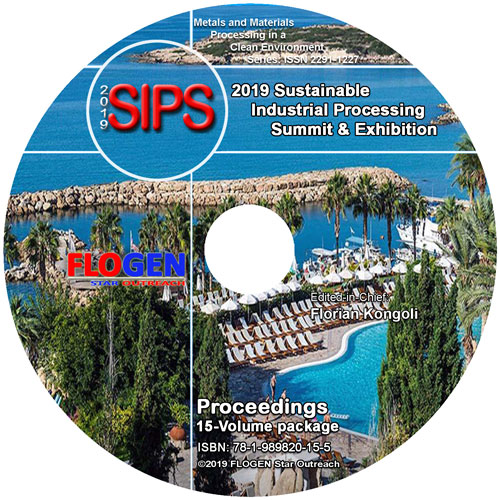2019-Sustainable Industrial Processing Summit
SIPS2019 Volume 8: Usui Intl. Symp. / Advanced Sustainable Iron and Steel Making
| Editors: | F. Kongoli, P. Assis, M.C. Gomez-Marroquin, S. Kitayama, H. Konishi, A. Murao, S. Nomura, H. Ono, H. Saxen, K. Seto, J.I. Tani |
| Publisher: | Flogen Star OUTREACH |
| Publication date: | 20 December 2019 |
| Pages: | 250 pages |
| ISBN: | 978-1-989820-07-0 |
| ISSN: | 2291-1227 (Metals and Materials Processing in a Clean Environment Series) |

CD shopping page
A Combined Thermochemical and Biotechnological Route to Produce Hydrogen Using Cassava Residues: Preliminary Results and Materials Characterization
Cintia de Faria Ferreira Carraro1; Carla Cristina de Almeida Loures1; Jose Adilson de Castro2;1CEFET-ANGRA DOS REIS, Angra dos Reis, Brazil; 2UFF - FEDERAL FLUMINENSE UNIVERSITY, Volta Redonda, Brazil;
Type of Paper: Regular
Id Paper: 227
Topic: 2
Abstract:
The industry of cassava represents an important source of residues commonly released in the environment. Special concerns are raised about the cassava bagasse and the waste water residue produced during the processing steps. In this study, we propose a sustainable route, which involves two steps of gas production. A first step uses the cassava bagasse in a thermal reactor to produce rich hydrogen gas suitable for use in the direct reduction processes. Then the waste water is treated in a biotechnological reactor using algae to produce hydrogen. To characterize the thermochemical processing step of the cassava bagasse decomposition, thermogravimetric analyses (TGA) and simultaneous differential scanning calorimetry (DSC) were carried out in a broader range of temperature and gas flow rates. This was done using the design of experiment techniques (DOE) to draw generalized correlations. In the second step of the waste water processing treatment, the concentrations and the culture conditions of the Chlorella minutissima microalgae were investigated. This was done to design feasible controllable parameters to maximize hydrogen production under the laboratory batch. Results indicated that gasification of the cassava bagasse presented high conversion rates in the temperature range of 600-700°C. Additionally, the microalgae conversion is proved possible in near environment temperatures under a controlled environment.
Keywords:
Gas; Hydrogen; Sustainability; Technology; Waste;References:
[1] SOCCOL, C.R. Biotechnological products from cassava roots by solid state fermentation. Journal of Scientific and insdutrial research, v.55p. 358-364, 1996.[2] NAJAFI, G.; GHOBADIAN, B.; YUSAF, T. F. Algae as a sustainable energy source for biofuel production in Iran: a case study. Renew Sustain Energy, v. 15, p. 3870-3876, 2011.